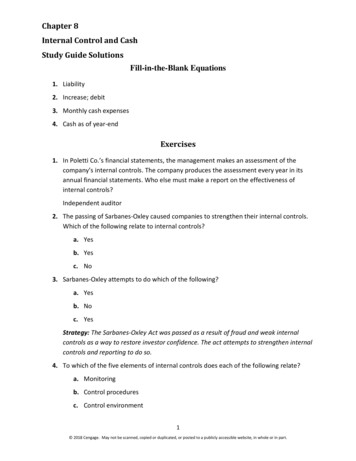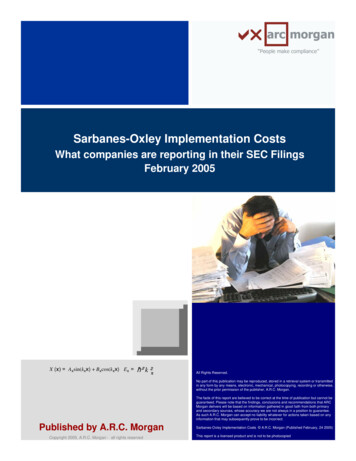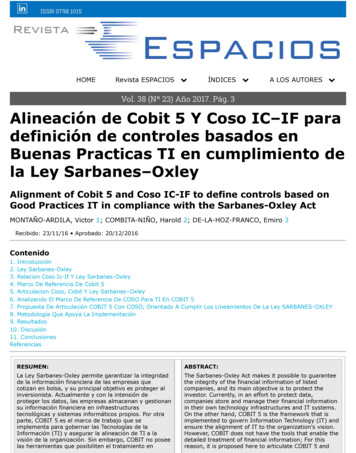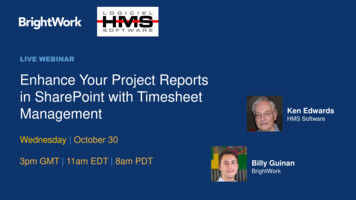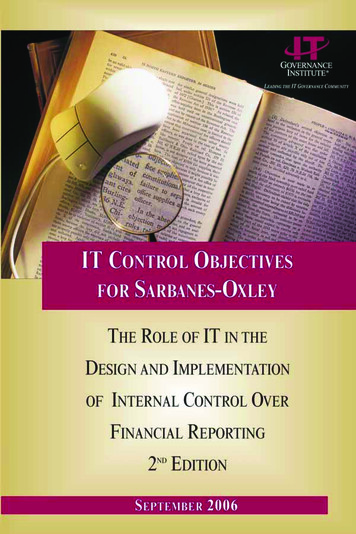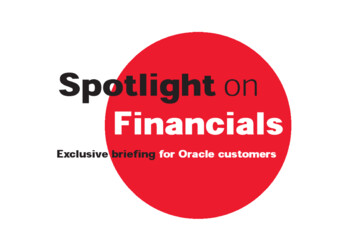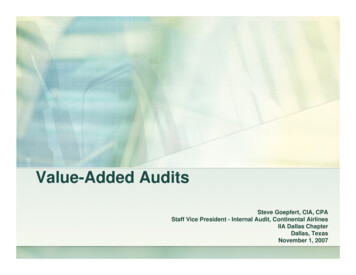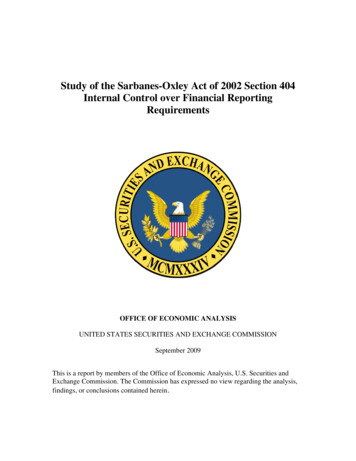
Transcription
Study of the Sarbanes-Oxley Act of 2002 Section 404Internal Control over Financial ReportingRequirementsOFFICE OF ECONOMIC ANALYSISUNITED STATES SECURITIES AND EXCHANGE COMMISSIONSeptember 2009This is a report by members of the Office of Economic Analysis, U.S. Securities andExchange Commission. The Commission has expressed no view regarding the analysis,findings, or conclusions contained herein.
Table of ContentsExecutive Summary . 1I.Introduction . 15II.Institutional Background and Questions for Research: the Sarbanes-Oxley Act of2002 and the Commission’s Rulemaking under Section 404 . 16III.Web Survey Design, Administration, and Characteristics of Respondents . 21IV.Evidence on Issuers’ Experience with Section 404 Compliance: Analysis of WebSurvey Data. 37a. The Cost of Complying with Section 404 . 37b. The Benefits of Complying with Section 404. 56c. The Effects of Management Guidance and Auditing Standard No. 5 on Section404 Compliance Procedures . 68V.Outsiders’ Perspective on the Effects of Section 404: Discussion of In-DepthInterviews with External Users of Financial Statements and Independent Auditors 84a. Objective, Broad Scope, and Subjects of the In-Depth Interviews. 84b. Interviews with External Users of Financial Statements . 86c. Interviews with Auditors . 92VI.Conclusion . 95Appendix A. SEC’s Regulatory History of Section 404 from 2003 to 2008. 98Appendix B. Section 404 Web Survey Questionnaire . 99
Executive SummaryThe Public Company Accounting Reform and Investor Protection Act, otherwise known asthe Sarbanes-Oxley Act (the “Act”), was enacted in July 2002 after a series of high-profilecorporate scandals involving companies such as Enron and Worldcom. Section 404(a) of the Actrequires management to assess and report on the effectiveness of internal control over financialreporting (“ICFR”). Section 404(b) requires that an independent auditor attest to management’sassessment of the effectiveness of those internal controls. Because the cost of complying with therequirements of Section 404 of the Act (“Section 404”) has been generally viewed as beingunexpectedly high,1 efforts to reduce the costs while retaining the effectiveness of complianceresulted in a series of reforms in 2007.This report presents an analysis of data from publicly traded companies collected from anSEC-sponsored Web survey of financial executives of companies with Section 404 experienceconducted during December 2008 and January 2009. The analysis of the survey data is designedto inform the Commission and other interested parties as to whether changes occurring since 2007are having the intended effect of facilitating more cost-effective internal controls evaluations andaudits, especially as they may apply to smaller reporting companies. The findings of the analysisrelating to efficiency include evidence on the total and component compliance costs, the changesin costs over time, and the factors that help to explain why costs are lower or higher for somecompanies than for others. These findings include evidence of direct and indirect effects thatmanagement ascribes to Section 404 compliance, including evidence on intended benefits.The 2007 reforms that are the focus of this inquiry include the SEC’s June 2007Management Guidance and its order approving the Public Company Accounting OversightBoard’s (PCAOB) Accounting Standard No. 5 (AS5) (collectively referred to as the “2007reforms”). We are primarily interested in whether and how companies’ experience with Section404(b) compliance changed following the reforms, yet this report also presents evidence on theimplementation of both Section 404(a) and Section 404(b). This reflects the interrelationshipbetween the two requirements. The survey was open to all reporting companies with relevantexperience in complying with Section 404, recognizing that only large accelerated filers andaccelerated filers are currently required to comply with both Section 404(a) and Section 404(b)1See, e.g., Speech by SEC Staff: Remarks before the Practising Law Institute Fifth Annual Institute onSecurities Regulation in Europe, by Alan L. Beller, Director, Division of Corporation Finance (Dec. 5,2005), available at http://www.sec.gov/news/speech/spch120505alb.htm (“The unexpectedly high costs ofcompliance with the internal control assessment, reporting and audit requirements have caused continuingfocus on [companies who are deregistering].”).1
and, thus, have information on the overall cost of compliance with these sections.Theseexperienced filers that responded to the survey tend to have public float in excess of 75 million,which is large compared to that of non-accelerated filers that are not yet required to comply withSection 404(b). The evidence on the experiences of larger companies may be useful in evaluatingthe extent to which additional improvements to the implementation of Section 404(b) should beundertaken before it becomes applicable to non-accelerated filers. Notwithstanding, it isimportant to highlight that the analysis in this report is not designed to provide compliance costestimates for companies that have yet to comply with the relevant requirements of Section 404.The general conclusion from the analysis of survey data is that compliance costs vary withcompany size (increasing with size), compliance history (decreasing with increased complianceexperience), and compliance regime (lower after the 2007 reforms). Larger companies tend toincur higher compliance costs in dollar terms (“absolute cost”), while smaller companies reporthigher costs as a fraction of asset value (“scaled cost”). The evidence suggests that companiesbear some fixed start-up costs of compliance that are not scalable. Some of these costs arerecurring fixed costs, while others are one-time start-up costs borne in the first years ofcompliance that tend to dissipate over time. For companies complying with both parts of Section404, the cost of complying with Section 404(b) is reportedly similar to the incremental cost ofcomplying with Section 404(a) alone. The resource requirements of Section 404(a) and Section404(b) compliance are quite different, however. The Section 404(a) cost is borne throughincreased internal labor and outside vendor expenses, while the Section 404(b) cost isexperienced primarily through increased independent-auditor fees, according to the surveyevidence.The evidence also indicates that there is an economically and statistically significantreduction in Section 404 compliance costs following the 2007 reforms. This reduction is mostpronounced among larger companies. More than half of survey participants (henceforth alsoreferred to as “respondents”) who answered explicit questions about the effects of the 2007reforms report that the reforms led to a decrease in compliance costs, consistent with theobjectives of the reform and the reported cost reductions. Nearly all respondents indicated thatthey relied on the Management Guidance and, of those, a majority found it to be useful. As aresult of the Management Guidance, there has been a shift of effort among smaller companiestoward evaluating the effectiveness of ICFR and away from the tasks of identifying risks to thecompany’s financial reporting and identifying controls that address identified risks. Theserespondents, however, had a less favorable response to a question about the SEC’s responsivenessto concerns about compliance costs.2
The Web survey also included questions about respondents’ perceptions of other potentialeffects of Section 404 compliance, including potential beneficial effects. Respondents ascribesome beneficial effects to Section 404 compliance. In particular, respondents were more likely toreport direct benefits of compliance with Section 404 rules (i.e., improvements directly related toa company’s financial reporting process, such as the quality of the company’s ICFR), rather thanindirect benefits of compliance (i.e., improvements indirectly related to a company’s financialreporting process, such as the company’s ability to raise capital). Respondents from largercompanies and Section 404(b) companies tend to regard Section 404 compliance more favorablythan those from their counterparts in almost every respect.Before turning to a more detailed outline of findings, it will be useful to provide somebackground on the size and compliance categories of the companies that are the subject of thestudy. Throughout the analysis, respondents are partitioned based on the size of their companyusing the size thresholds that parallel the SEC’s reporting thresholds.2 Under SEC regulations—typically—non-accelerated filers have public float of less than 75 million; accelerated filershave public float between 75 million and 700 million; and large accelerated filers have publicfloat of 700 million or more.3 The evidence on the costs and benefits of Section 404(b)compliance is almost entirely from the last two groups, which are termed “large” and“medium/mid-sized” companies in this report, because “small” companies (with public float lessthan 75 million) were typically not yet required to comply with Section 404(b) at the time of thesurvey.4 Following previous research, in some instances, the analysis of smaller companiesfocuses on those having a public float falling within a band above and below the 75 millionthreshold that distinguishes non-accelerated from accelerated filers.5 In addition, to separate the2Size categories are determined by the company’s market value of public float (henceforth, “publicfloat”) measured two quarters prior to the relevant fiscal year end date.3It should be noted that this is a loose characterization of filer status—the actual definitions involveadditional requirements. For the definitions of accelerated filers and large accelerated filers, see ExchangeAct Rule 12b-2, 17 CFR §240.12b-2. Non-accelerated filers are companies that do not meet the ExchangeAct definition of an accelerated filer or large accelerated filer. See, e.g., “Revisions to Accelerated FilerDefinition and Accelerated Deadlines for Filing Periodic reports,” SEC Release No. 33-8644 (Dec. 21,2005), 70 FR 76626, available at http://www.sec.gov/rules/final/33-8644.pdf.4See infra Part II.5Cf. Peter Iliev, “The Effect of SOX Section 404 Compliance on Audit Fees, Earnings Quality andStock Prices”, Journal of Finance, forthcoming (2009), available at http://ssrn.com/abstract 983772(examining companies with public float between 50 million and 100 million for similar reasons). Thisstands in contrast with the dollar thresholds— 75 million and 700 million—that delineate the differentregulatory compliance categories (i.e., non-accelerated, accelerated, and large accelerated filers). Whilepublic float is not alone sufficient to determine a company’s regulatory compliance category under SECrules, it is clear that none of the companies that had a public float of less than 75 million around the time3
effects of Section 404(a) compliance from those of Section 404(b), when appropriate the analysispartitions companies that were compliant with both Sections 404(a) and 404(b) in the relevantfiscal year (henceforth “Section 404(b) companies”)6 from those that are compliant with Section404(a) only (henceforth “Section 404(a)-only companies”).A more detailed presentation of findings as answers to the central questions of the reportfollows:Q1. How does the cost of complying with Section 404 vary across companies, and whatfactors influence a company’s compliance cost?The total cost of complying with Section 404 varies across companies depending on (1) thecompany’s size, (2) whether the company is complying with Section 404(a) only or also withSection 404(b), (3) the company’s experience in complying with Section 404(b), and (4) whethercompliance occurred before or after the 2007 reforms. Specifically, the absolute compliance costin dollar terms tends to increase with company size (measured by public float), but the cost scaledby asset value tends to decline as company size increases. As one would expect, total compliancecosts are typically larger for companies complying with Section 404(b) in addition to Section404(a). Longer experience with Section 404(b) compliance, however, is associated with adecrease in the typical reported costs (scaled by company assets). The cost of compliance tends tobe lower after the 2007 reforms than before and this decrease is most pronounced among largercompanies.Q2. What is the observed trend in Section 404 compliance cost before and after the 2007reforms?The Web survey collected response data on audit fees, outside vendor fees, non-labor costs,and internal labor hours. These cost components were aggregated using conservative assumptionsin order to obtain a dollar estimate of the total cost of compliance (see Section IV.a).The evidence generally indicates that the typical total compliance costs have decreased fromthe year prior compared to the one after the 2007 reform and are expected to decrease further inthe fiscal year in progress at the time of the survey. Among Section 404(b) companies, the meantotal Section 404 compliance cost drops significantly from 2.87 million pre-reform to 2.33of the survey would have had to comply with the auditor attestation requirements of Section 404(b) (unlessthey previously had public float above 75 million).6We relied on Audit Analytics for the information regarding whether a company filed a Section404(a) report and/or a Section 404(b) report. We did not independently verify this information except in afew cases where the company’s public float would indicate otherwise.4
million post-reform, representing a 19 percent decline in the total compliance cost (see Table 8).The compliance cost is expected to be lower still, with a mean cost of 2.03 million, representinga combined decline of 29 percent (see Table 8). When reporting compliance costs by sizecategory, the mean total compliance cost decreases from 769,000 to 690,000 among filers withpublic float lower than 75 million, but this difference is not statistically significant.7 Thereduction in compliance costs is more pronounced among the medium and large companies thatare already required to comply with Section 404(b) (see Table 9).The medians reveal similar patterns for the typical company in our sample.8 The mediantotal Section 404 compliance cost declines significantly from 1.19 million pre-reform to 1.04million post-reform, a 13 percent decline (see Table 8). The median expected cost for the fiscalyear in progress is lower still, at 905,000, a combined decline of 24 percent relative to the prereform median cost (see Table 8). For non-accelerated filers, the median total compliance costdecreased from 579,000 to 439,000, but, as with the means, the difference for these companiesis not statistically significant.When analyzing first-time compliance costs before and after the 2007 reforms, the resultsare mixed and the mean decrease in total costs is not statistically significant (see Table 13). Incontrast, for companies in their second year of compliance with Section 404(b), both the meanand median compliance costs are significantly lower after the 2007 reforms than before.Meanwhile, among Section 404(a)-only companies, the mean total cost also decreased from 425,000 pre-reform to 336,000 post-reform, but the difference is not statistically significant,and the median cost actually increased from 111,000 to 162,000. Both the mean and themedian, however, are expected to decrease for the fiscal year in progress at the time of the survey(see Table 8).Q3. How do the component costs of complying with Section 404 compare, and how havethey changed since the 2007 reforms?For Section 404(b) compliant companies, the largest cost component is internal labor costs—which can comprise more than 50 percent of the total compliance cost—followed by theestimated portion of total audit fees attributed to ICFR (404(b) audit fees), outside vendor fees,and non-labor cost (see Table 8). In general, every component cost declines after the reforms7Filers with public float below 75 million complying with Section 404(b) may be either nonaccelerated filers choosing to comply with Section 404(b) (although not required to do so) or acceleratedfilers whose public float has dropped below 75 million but remained above 50 million.8Means and medians measure the central location of a distribution. For asymmetric distributionsusing medians instead of means, the weight placed on the extreme observations is reduced.5
compared to the year before, and is projected to decline further in the fiscal year in progress (seeTable 8). The most notable changes in the cost components between pre-reform and post-reformare observed in the outside vendor fees and the percent of the total audit fees attributable to ICFR(see Table 8). The mean outside vendor fee decreases by 29 percent from 438,000 pre-reform to 311,000. The median outside vendor fee decreases by 10 percent from 100,000 to 90,000.Both differences are statistically significant, and the outside vendor fees are expected to decreasesignificantly to a mean cost of 222,000 and median cost of 55,000 in the fiscal year in progressat the time of the survey (see Table 8). The mean portion of the audit fee that respondentsattributed to the ICFR audit also decreases significantly by 21 percent from 821,000 to 652,000. This decline is expected to continue. Similarly, the median audit fee decreases by 13percent from 358,000 to 311,000 and is expected to decrease to 275,000 (see Table 8).Q4. What are the benefits of complying with Section 404, as reported by companyexecutives, and how do they compare against the costs of compliance?The survey asked the respondents to comment on the impact of Section 404 compliance ontwelve characteristics relating to internal governance and investor confidence, of which six wereconsidered direct effects of compliance and the remaining six indirect effects of compliance. Therespondents recognized Section 404 compliance as having a positive impact on variousdimensions of the financial reporting process, but were less inclined to recognize theseimprovements as affecting the companies’ dealings with other capital market participants.Furthermore, in an optional section of the survey, respondents provided their assessment ofthe cost-benefit trade-off of Section 404 compliance. The majority of respondents to this sectionperceive the trade-off to be negative to varying degrees.This perceived trade-off is morefavorable among larger companies and, independently of size, improved following the 2007reforms (see Table 15).Among the characteristics that are most widely reported benefiting from Section 404compliance is: the quality of the respondent company’s internal control structure (73 percent), theaudit committee’s confidence in the company’s ICFR (71 percent), the quality of the company’sfinancial reporting (49 percent), the company’s ability to prevent and detect fraud (48 percent),and the respondent’s confidence in the financial reports of other companies complying withSection 404 (40 percent) (see Table 14). The majority of respondents recognize no effect ofSection 404 compliance on: the company’s ability to raise capital, investor confidence in thecompany’s financial reports, the company’s overall firm value, and the liquidity of the company’scommon stock. Finally, the perceived effect of Section 404 compliance on the efficiency of the6
operating and financial reporting processes and the timeliness of the company’s financialstatement audit varies widely: while a majority of respondents perceive no effect on thesedimensions, non-trivial portions of respondents recognize a negative effect—that is, a reductionin the efficiency of the operating and financial reporting processes and/or the timeliness offinancial statement audit (see Table 14). In the cross-section, larger companies were more likelyto ascribe positive direct and indirect effects to Section 404 compliance than were smallercompanies.Q5. What are the reported benefits of Section 404 compliance from the perspective offinancial statement users?In order to obtain a more complete picture of the effects of Section 404 implementation, staffmembers from the SEC’s Office of the Chief Accountant conducted separate in-depth phoneinterviews of a sample of 30 users of financial statements—including lenders, securities analysts,credit rating agencies, and other investors. Although the sample is admittedly smaller than that ofissuers participating in the survey, the evidence gathered is useful because it provides theperspective of financial statement users on the effects of Section 404 compliance.In general, financial statement users regard ICFR disclosures to be beneficial and indicatedthat Section 404(a) and Section 404(b) compliance has had a positive impact on their confidencein the companies’ financial reports. The users generally indicate that Section 404 complianceleads management to better understand financial reporting risks, put in place appropriate controlsto address financial reporting risks, and address internal control deficiencies in a more timelyfashion than in the absence of the disclosure requirement. Although, users offer divergentopinions regarding the extent to which disclosures of material weakness affect their decisionmaking process, most agree that severe weaknesses that could take years to remediate are likelyto negatively affect their decision-making.Users tend not to perceive the benefits of Section 404 compliance to vary with the size of thereporting company. Instead, many indicate that these benefits depend on a company’s complexityand industry affiliation. At the same time, the users agree that variations in compliancerequirements based on complexity and/or industry would likely be impractical. Finally, mostusers indicate that the benefits they perceive from Section 404 compliance have not changedsubstantially over time. This is an important finding since it indicates that the 2007 reforms, whileintended to reduce certain duplicative efforts in conducting the evaluation of ICFR, did not at thesame time change financial statement users’ perception of the effectiveness of Section 404.7
Regarding the Section 404(b) requirement, the general consensus is that the auditor’s reporton ICFR required under Section 404(b) provides an incremental benefit beyond themanagement’s report because many respondents perceive the audit requirement to providenecessary discipline to the reporting process. Although some users express the concern that ICFRevaluation may divert management’s attention from other important areas of their businesses,these respondents continued to believe that strong ICFR is necessary and that financial statementsneed to be of high quality and reliable.Most users interviewed indicate that the process of compliance with Section 404 has becomemore efficient since the initial implementation in 2004 due to: (i) reduction in the level ofdocumentation, (ii) improved communications between auditors and management, (iii) increaseduse of professional judgment in scoping and testing, (iv) more focus on higher risk areas, and (v)streamlining of audits subsequent to the first-time effort required by Section 404 compliance.Q6. In what ways have the Commission’s 2007 reforms affected the companies’ proceduresof complying with Section 404?Nearly all respondents who completed an optional section of the survey requesting feedbackon management’s Section 404(a) experience responded that they used Management Guidance andfound it to be useful (see Table 16). Those who responded indicate that both ManagementGuidance and Auditing Standard No. 5 have helped reduce the total cost of compliance, forcompanies in every size category (see Table 17). The respondents also indicate on average thatAuditing Standard No. 5 resulted in a small decrease in the time it takes to complete theindependent audit of ICFR (see Table 18). The perceived impact of AS5, however, varies with thesize of the company and its experience with Section 404(b) compliance. Specifically, theperceived impact of AS5 on the time it takes to complete the independent audit of ICFR issignificantly smaller among small filers and among companies with no previous experience withSection 404(b) compliance.When asked to compare the changes in activities associated with management’s evaluationof ICFR, the respondents indicate a slight decrease on average from pre-reform to post-reform inthe number of risks subject to testing, the number of controls tested, but a slight increase in thelevel of documentation, the use of management’s interaction with controls as evidence, relianceon evidence gained from self-assessment, and reliance on evidence from direct testing (see Table21). Like much of the previous results, the responses varied significantly depending on therespondents’ size. While smaller companies typically report an increase in every component, thechanges reported by medium and large filers are not homogenous. Interestingly, however, the8
evidence suggests that the compliance process across companies of different size has becomemore homogenous following the 2007 reforms. Finally, the survey evidence indicates thatcompanies are increasingly structuring their evaluations of ICFR with the intent of allowing theindependent auditor to rely on their internal work (see Table 22), which is consistent with one ofthe goals of the 2007 reforms through Auditing Standard No. 5.Some caveats about the analysis of Web survey data on Section 404 implementationThere are a number of caveats to consider when interpreting the evidence presented in thisstudy, some of which are due to the inherent nature of survey data, while others are the result ofthe particular context in which the Section 404 survey takes place.First, most, if not all, analyses of survey data are affected to various degrees by thefollowing potential difficulties: Self-Selection Bias (i.e., Non-response Bias): Participation in survey research is generallyvoluntary. The process by which survey participants “select” to participate in a survey canbias the inference based on survey data, if the participants’ (self-) selection process is suchthat particular segments of the population are systematically over- or under-represented. Weconduct extensive analyses to test for the presence and the potential severity of the problem,particularly by investigating the extent to which key characteristics of the sample ofrespondents to the survey coincide or diverge from those of the list of companies identified asthe target population (see Part III). We find that respondent companies are representative ofthe initial list of public companies identified for this study, particularly among Section 404(b)companies or within company size groups. We also find that the typical responses ofvoluntary participants in the survey are not significantly different from those of a randomlyselected, stratified sample of companies that were the target of follow-up efforts to inducetheir participation. Overall, the evidence is consistent with the notion that the voluntarynature of the participation introduces no bias in the responses, at least relative to the separatetreatment group where part of the decision to participate is a result of the follow-up effort. Response Bias: If there are no penalties for misrepresentation and survey participants havesystematic incentives to be less than fully truthful, inference based on survey data (or anyother self-reported information that meets those criteria) may not be accurate. A similarproblem arises when survey questions are designed to elicit the participant’s subjectiveperceptions on a particular subject and the participants’ views are systematically biased. Theportion of survey data that we could independently verify (i.e., audit fees) indicates that theparticipants’ representations do not deviate substantially from what is reported in official9
SEC filings.9 Aside from this exercise, it is virtually impossible to assess the extent to whichthe remaining survey data may not be accurate. The nature of the survey questions varies,with some questions focusing on quantifiable items (e.g., internal labor hours) and others ondirectional perceptions (e.g., assessment of the effect of Section 404 on the quality of ICFR)and others still on directional/ordinal perceptions (e.g., assessment of the effect of AS5 on theamount of time it takes to complete the independent audit under Section 404(b)). Thecommon element, however, is that these data cannot be independently verified, either becausecompanies are do not keep a separate record of the figures provided (e.g., costs) or becausethe information provided is based on the respondents’ perceptions which by their very natureare not verifiable. The analysis in this report provides a characterization of com
As one would expect, total compliance costs are typically larger for companies complying with Section 404(b) in addition to Section 404(a). Longer experience with Section 404(b) compliance, however, is associated with a decrease in the typical reported costs (scaled by company assets). The cost of compliance tends to


